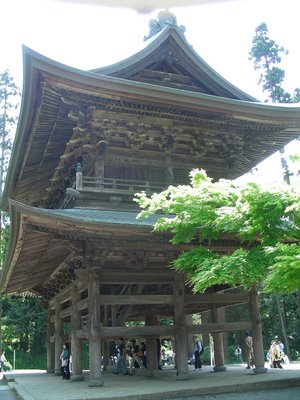
We went back to Kamakura the next morning to see Engaku-ji. It's San-mon or inner gate is pictured above. It is the head temple (honzan) of the Engaku-ji school of Rinzai Zen. It has a very interesting history--it was built in 1282 one year after an attempted invasion by the Mongols under Khubilai Khan (grandson of Ghengis Khan) was reverted. Part of the purpose of the new temple was to honor the war dead--of both the Mongols and the Japanese. For more on the history of Engakuji
click here.
It was also the temple that Soen Shaku trained at. He became one of the first people to introduce Zen Buddhism to the west when he attended a world religious convention held in Chicago in 1893.

Intricately carved woodwork on one of the gates.

A misty shot of the Buddha in the main hall, taken from outside the front door.

Some orchids growing on a very old tree whose branches were being held up by posts that were lashed to them with rope.

The great bell (O-gane) of Engakuji, which is a national treasure of Japan.
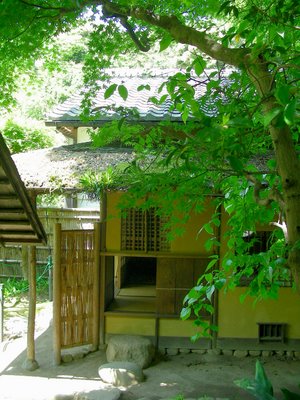
A tea-house on the temple grounds. Here you can see the half door entry way. They were made this way so that everyone had to stoop down and crawl to enter them in the same way, regardless of their rank in the outside world.
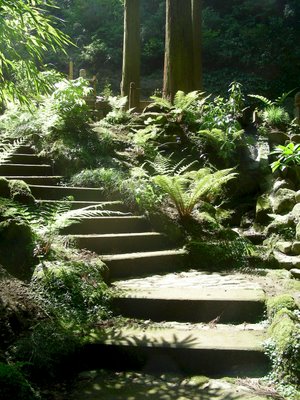
Stairs leading up into a graveyard behind a smaller temple that was across the railroad tracks from Engakuji. I don't remember the name of it--only that it was established as a nunnery but wasn't active anymore.

Another Buddha statue up in the graveyard.
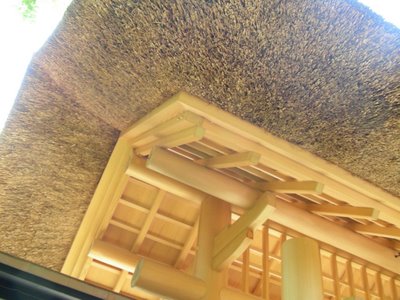
This is a shot up into the roof of the gate to the small temple with the graveyard steps shown above. It was a newly built gate, but it's really rare to see thatched roofs anymore--here you can sort of see how they're made.
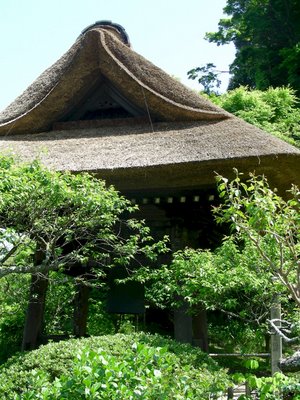
Another thatched roof on that temple's grounds. This one is covering their great bell.
 We went back to Kamakura the next morning to see Engaku-ji. It's San-mon or inner gate is pictured above. It is the head temple (honzan) of the Engaku-ji school of Rinzai Zen. It has a very interesting history--it was built in 1282 one year after an attempted invasion by the Mongols under Khubilai Khan (grandson of Ghengis Khan) was reverted. Part of the purpose of the new temple was to honor the war dead--of both the Mongols and the Japanese. For more on the history of Engakuji click here.
We went back to Kamakura the next morning to see Engaku-ji. It's San-mon or inner gate is pictured above. It is the head temple (honzan) of the Engaku-ji school of Rinzai Zen. It has a very interesting history--it was built in 1282 one year after an attempted invasion by the Mongols under Khubilai Khan (grandson of Ghengis Khan) was reverted. Part of the purpose of the new temple was to honor the war dead--of both the Mongols and the Japanese. For more on the history of Engakuji click here. It was also the temple that Soen Shaku trained at. He became one of the first people to introduce Zen Buddhism to the west when he attended a world religious convention held in Chicago in 1893.
It was also the temple that Soen Shaku trained at. He became one of the first people to introduce Zen Buddhism to the west when he attended a world religious convention held in Chicago in 1893. Intricately carved woodwork on one of the gates.
Intricately carved woodwork on one of the gates. A misty shot of the Buddha in the main hall, taken from outside the front door.
A misty shot of the Buddha in the main hall, taken from outside the front door. Some orchids growing on a very old tree whose branches were being held up by posts that were lashed to them with rope.
Some orchids growing on a very old tree whose branches were being held up by posts that were lashed to them with rope. The great bell (O-gane) of Engakuji, which is a national treasure of Japan.
The great bell (O-gane) of Engakuji, which is a national treasure of Japan. A tea-house on the temple grounds. Here you can see the half door entry way. They were made this way so that everyone had to stoop down and crawl to enter them in the same way, regardless of their rank in the outside world.
A tea-house on the temple grounds. Here you can see the half door entry way. They were made this way so that everyone had to stoop down and crawl to enter them in the same way, regardless of their rank in the outside world. Stairs leading up into a graveyard behind a smaller temple that was across the railroad tracks from Engakuji. I don't remember the name of it--only that it was established as a nunnery but wasn't active anymore.
Stairs leading up into a graveyard behind a smaller temple that was across the railroad tracks from Engakuji. I don't remember the name of it--only that it was established as a nunnery but wasn't active anymore. Another Buddha statue up in the graveyard.
Another Buddha statue up in the graveyard. This is a shot up into the roof of the gate to the small temple with the graveyard steps shown above. It was a newly built gate, but it's really rare to see thatched roofs anymore--here you can sort of see how they're made.
This is a shot up into the roof of the gate to the small temple with the graveyard steps shown above. It was a newly built gate, but it's really rare to see thatched roofs anymore--here you can sort of see how they're made. Another thatched roof on that temple's grounds. This one is covering their great bell.
Another thatched roof on that temple's grounds. This one is covering their great bell.